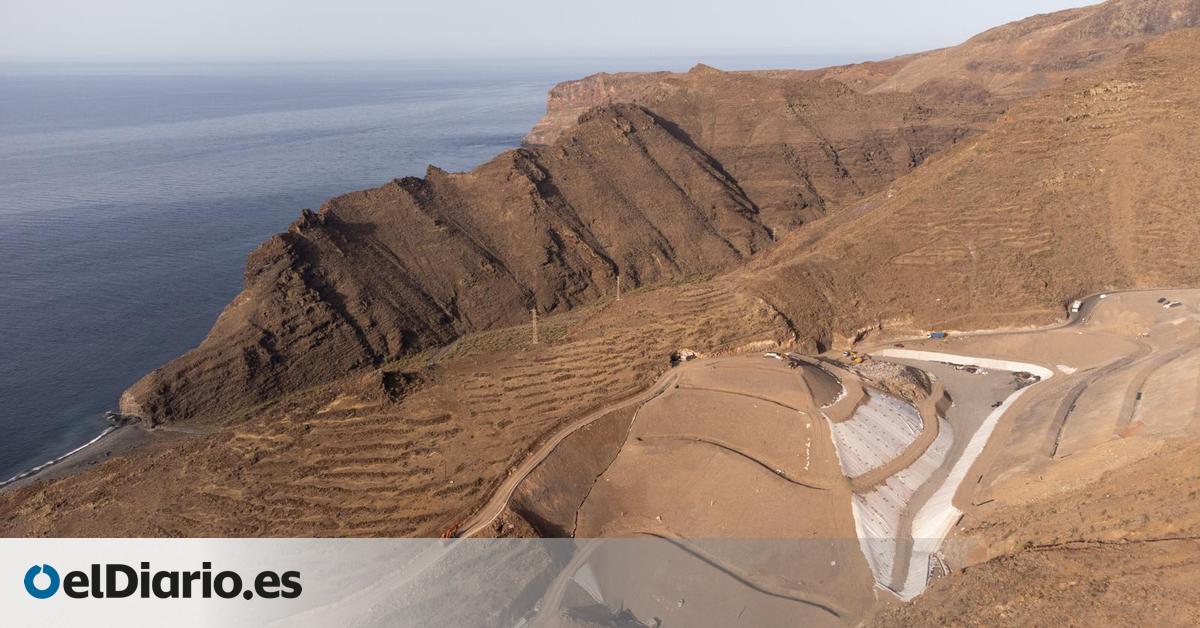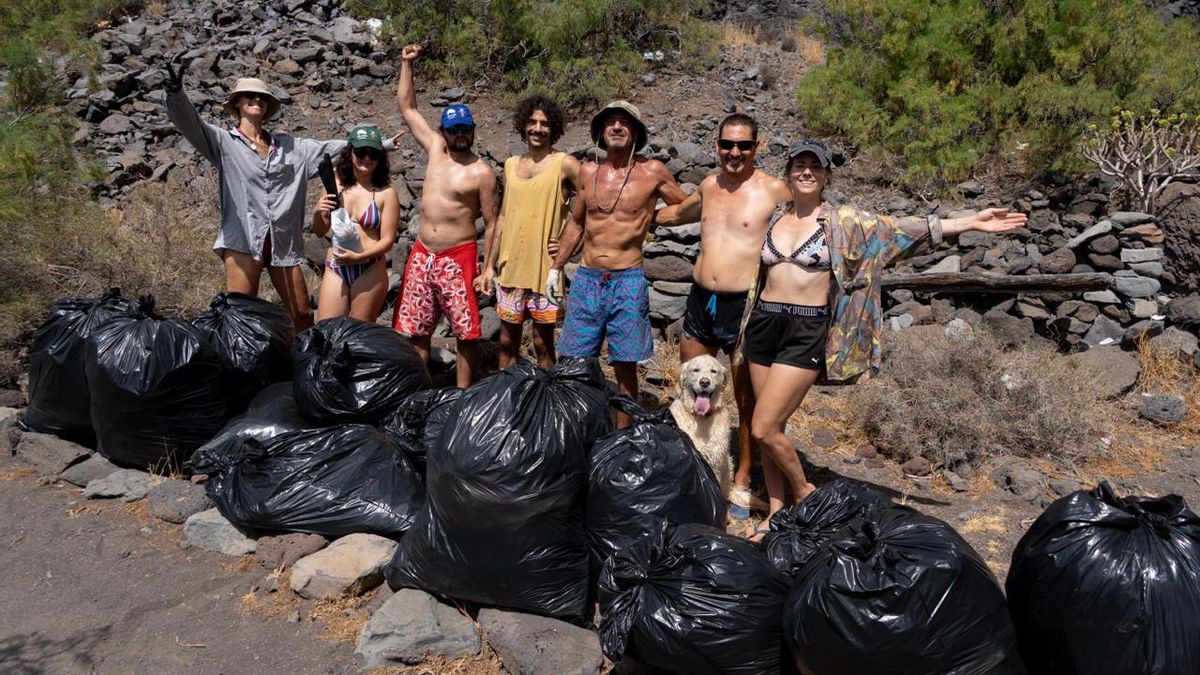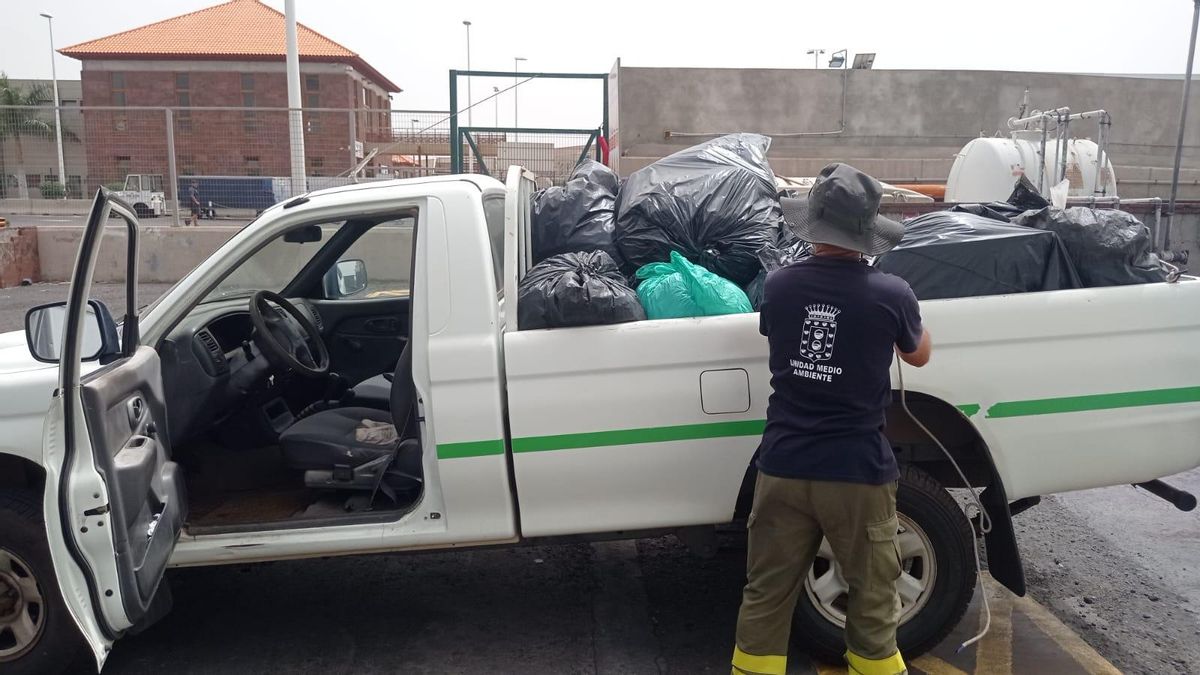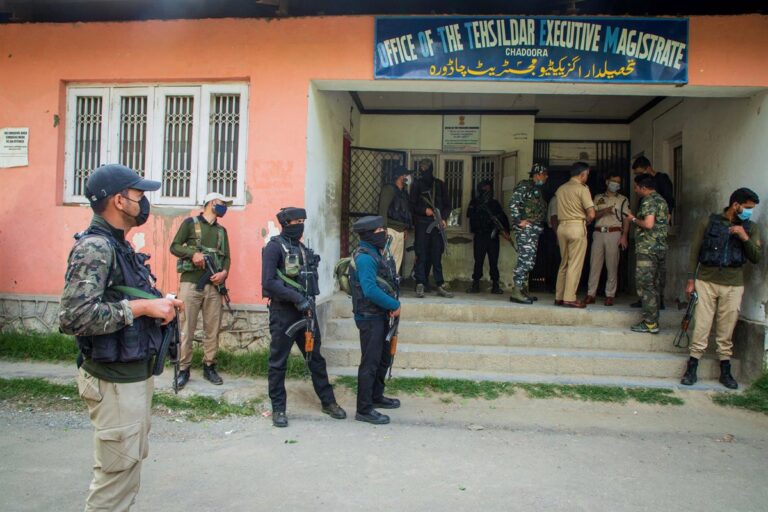
The only legal landfill on La Gomera is located in the capital, San Sebastian de La Gomera. The facility was opened a little more than 20 years ago in an area adjacent to the Barranco del Cabrito Natural Monument and half a kilometer from the coast. This is a place where the wind blows strongly. That is why a wind turbine was built near it in 2023. And when there are strong wind gusts, a small part of the garbage that reaches the environmental complex ends up on the beaches of La Guancha, which have long been frequent victims of plastic pollution.
Volunteers collect “over 100, 150 kilograms” of lightweight plastic along the coastline “every two to three weeks.” An interactive map by the Gomera Tamashii and Environmental Cleaning Association (Agrama), an organization that has been voluntarily cleaning the island’s beaches since 2018, says the level of dirt is “extreme.”
“It’s quite a lot. When the wind blows, plastics, especially supermarket bags, come out of the glass (from the landfill) and are scattered all over the region,” laments Agrama president Hugo Peruna. The complex is “like a crater,” the man continues, “all the trash is dumped and then it’s filled with dirt. But there’s always a hole,” and from there the ruins come out and end up around the universe.
When they return to the beach for a new cleaning campaign, the panorama is “always the same,” Peruna says. He and his team will collect “a ton of plastic,” separate it, store it in a booth, and later load it onto government trucks for recycling. He claims to have seen waste even in the deep sea.

In a video posted on social networks, Agrama explains that one day while collecting “floating plastic” from the sea near La Guancha, he came across a pair of pilot whales, which gave him “one more reason to care for our oceans.”
La Gomera’s parliament claims there is a “special program” in which €3 million a year will be donated to “clean up the entire environment”. A spokesperson for the island corporation confirmed that “winds in the area can cause material to fall from the environmental complex,” and that “we therefore frequently patrol hillside and coastal areas to remove material.”
He added that “at least” one raid a month is carried out in groups of five to 10 workers. And he added that Agrama is indeed “agreeing” to “awareness-raising activities through clean-up activities in the area with citizen participation.” This condition is expected to remain in place until further notice. He stresses that services are “always enhanced” during periods of trade winds. “We’re lucky to have a perfectly mimicked environmental complex,” he points out.
Hikers walking along La Guancha also point out the amount of trash. Sources at Finca El Cabrito, which is located just over a mile from the landfill, claim that their customers “are complaining a lot because they usually walk regularly to San Sebastian de la Gomera” and have observed bodies escaping from the complex.
The facility said it had also submitted documents to European authorities because “when the wind blows, garbage is scattered all over the slopes of La Guancha Valley, which is part of the Barranco del Cabrito Natural Monument.” These same sources point out that the hotel hosts people who have “participated in European politics” and that these customers have “transferred the problem beyond Spain.”
However, the response received was “neutral”. Finca El Cabrito’s words conclude simply: “We evaluate it and take it into account. Nothing more.”

The central controversy lies in the location of this environmental complex, called El Revolcadero. According to the La Gomera Waste Master Plan, the island generated more than 12,600 tons of waste in 2020, according to the latest data. Most of that trash was not recycled and was mixed.
In fact, La Gomera has the “lowest recycling rate in the Canary Islands,” the document details. And “this may all be due to the fact that the council did not launch a selective collection service for paper and cardboard in addition to light packaging for all municipalities on the island until April 2019,” he points out.
“The island has huge deficiencies in the management of all types of waste, and is probably in the worst position in adapting and complying with laws on waste and contaminated soil for a circular economy,” Guzmán Correa, advisor to the island corporation’s Gomera Initiative, told the opposition.
El Revolcadero currently has a conversion plant, another transfer plant is planned to send mixed waste off the island, and a composting facility aimed at processing between 3,500 and 5,000 tons of organic debris per year. The goal is to ensure that by 2035, only 10% of the island’s waste ends up in landfills. Under our current model, 80% of all waste we generate ends up in landfills.
Due to the accumulation of waste in the complex’s basin, the La Gomera city council declared in 2020 an “imminent threat” of damage to the environment and public health due to the “imminent depletion” of drainage capacity. The condition of the cells was “critical.” The Canary Islands government commissioned TRAGSA to build the new project for 6.5 million euros, but exempted it from the environmental evolution mandate due to “implementation urgency”. The island corporation says it has no intention of moving its location to another point on the island.
“In the framework of the territorial plan as an island in a biosphere reserve, La Gomera does not in any case propose a change of location. It would be nonsense to do such a thing, since what we want is to preserve the territory. The appearance of plastic on the slopes and on the coast happens exactly when the wind blows,” the Cabildo spokesperson reiterated.

“Sure, if one space deteriorates, what are you going to do? Degrade another space?” asks Leila Rodriguez, the council’s PSOE advisor. Rodríguez, who was a member of the San Sebastian de la Gomera city council, remembers that the city council initially rejected the construction of El Revolcadero “because of its proximity to the coast and the El Cabrito nature reserve.”
The scope of the impact, the counselor argues, “will continue to impact the environment, just as it has in the past.” And the impact is now “obvious,” he stresses. “You just have to ask. There are a lot of people here who do mountain tourism, hiking tourism, or marine activities, and they realize that the[ocean]bottom is not good,” he points out.
A report by Ben Magec-Ecologistas en Acción, signed in 2003, concluded that El Revolcadero was a “controversial” facility from the beginning, as “no city council intended to locate the power plant within the city limits.”
The city of San Sebastian de la Gomera vetoed it “unanimously” in 1993, the report details. However, the Canary Islands government and parliament approved its final establishment on the island in 1996, and Casimiro Curbelo (Gomera Socialist Group) became the head of the island corporation, a position he continues to hold almost 30 years later. “His standards were imposed,” Rodriguez criticized.
Ben Majek’s article indicates that a legal battle ensued between the San Sebastian de la Gomera City Council and the Congress. The City Council filed an administrative challenge and complaint with the European Commission, alleging, among other things, “the lack of explicit authorization for the project and the failure of the environmental impact study to include the investigation of alternative sites.” However, in 2002 the Canary Islands High Court dismissed the appeal.
“The fact that plastic is constantly reaching La Guancha Beach and the valley, given the proliferation of plastic that this post-modern life has brought about, as well as the prevailing winds in the area (there’s a reason they put the wind farm there), should have been taken into account when drafting the project,” Correa says.
“They should have established preventive and corrective measures to prevent this from happening,” he added. “(Congress) has made environmental protection a volunteer activity,” Rodriguez concluded.
“Do we know how much material degrades between cleanups? And how much remains as microplastics? Do we know how much material goes undetected in searches because it hides under stones, or how much falls directly into the ocean? Basing these actions almost exclusively on volunteer work could be counterproductive,” Correa questions. In particular, he says, “we know how willing the authorities in Gomera are to look for easy solutions that do not address the problem in a comprehensive way.”



